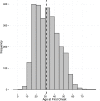Epidemiology and Heritability of Major Depressive Disorder, Stratified by Age of Onset, Sex, and Illness Course in Generation Scotland: Scottish Family Health Study (GS:SFHS)
- PMID: 26571028
- PMCID: PMC4646689
- DOI: 10.1371/journal.pone.0142197
Epidemiology and Heritability of Major Depressive Disorder, Stratified by Age of Onset, Sex, and Illness Course in Generation Scotland: Scottish Family Health Study (GS:SFHS)
Abstract
The heritability of Major Depressive Disorder (MDD) has been estimated at 37% based largely on twin studies that rely on contested assumptions. More recently, the heritability of MDD has been estimated on large populations from registries such as the Swedish, Finnish, and Chinese cohorts. Family-based designs utilise a number of different relationships and provide an alternative means of estimating heritability. Generation Scotland: Scottish Family Health Study (GS:SFHS) is a large (n = 20,198), family-based population study designed to identify the genetic determinants of common diseases, including Major Depressive Disorder. Two thousand seven hundred and six individuals were SCID diagnosed with MDD, 13.5% of the cohort, from which we inferred a population prevalence of 12.2% (95% credible interval: 11.4% to 13.1%). Increased risk of MDD was associated with being female, unemployed due to a disability, current smokers, former drinkers, and living in areas of greater social deprivation. The heritability of MDD in GS:SFHS was between 28% and 44%, estimated from a pedigree model. The genetic correlation of MDD between sexes, age of onset, and illness course were examined and showed strong genetic correlations. The genetic correlation between males and females with MDD was 0.75 (0.43 to 0.99); between earlier (≤ age 40) and later (> age 40) onset was 0.85 (0.66 to 0.98); and between single and recurrent episodic illness course was 0.87 (0.72 to 0.98). We found that the heritability of recurrent MDD illness course was significantly greater than the heritability of single MDD illness course. The study confirms a moderate genetic contribution to depression, with a small contribution of the common family environment (variance proportion = 0.07, CI: 0.01 to 0.15), and supports the relationship of MDD with previously identified risk factors. This study did not find robust support for genetic differences in MDD due to sex, age of onset, or illness course. However, we found an intriguing difference in heritability between recurrent and single MDD illness course. These findings establish GS:SFHS as a valuable cohort for the genetic investigation of MDD.
Conflict of interest statement
Figures



References
-
- Global health estimates 2014 summary tables: DALY by cause, age and sex, 2000–2012 [Internet]. 2014 [cited 20 February 2015]. Available from: http://www.who.int/healthinfo/global_burden_disease/estimates/en/index2.....
-
- Andrade L, Caraveo-anduaga JJ, Berglund P, Bijl RV, Graaf RD, Vollebergh W, et al. The epidemiology of major depressive episodes: results from the International Consortium of Psychiatric Epidemiology (ICPE) Surveys. International journal of methods in psychiatric research. 2003;12(1):3–21. - PMC - PubMed
-
- Jenkins R, Bebbington P, Brugha TS, Farrell M, Lewis G, Meltzer H. British psychiatric morbidity survey. Br J Psychiatry. 1998;173:4–7. . - PubMed
-
- Kessler RC, Berglund P, Demler O, Jin R, Koretz D, Merikangas KR, et al. The epidemiology of major depressive disorder: results from the National Comorbidity Survey Replication (NCS-R). Jama. 2003;289(23):3095–105. - PubMed
Publication types
MeSH terms
Grants and funding
LinkOut - more resources
Full Text Sources
Other Literature Sources

